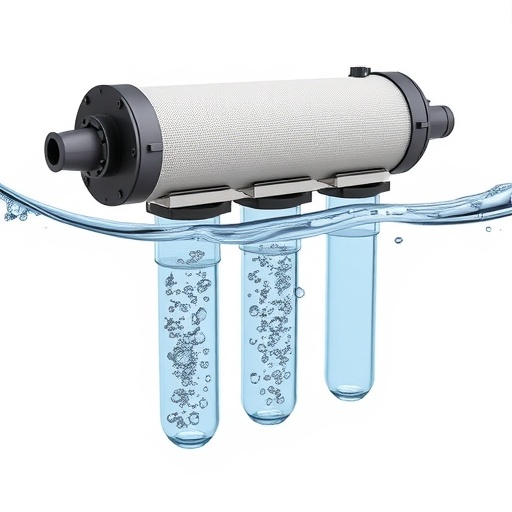In the face of accelerating climate change and soaring global population, the strain on freshwater resources has become one of the most pressing challenges of our time. Addressing this urgent need, researchers at Rice University, led by Menachem Elimelech and his former postdoctoral researcher Yanghua Duan, have unveiled a groundbreaking framework for designing catalytic reactive membranes that promise to revolutionize how we purify water. Their newly developed mechanistic model dives deep into the nanoscale processes inside membranes, offering unprecedented predictive power to optimize water treatment technologies moving forward.
At the heart of this pioneering work lies a fundamental shift in approach. Historically, advances in reactive nanofiltration membranes—the technology combining filtration with catalytic transformation of pollutants—have relied on trial-and-error experimentation. This empirical methodology has limited scientists’ and engineers’ abilities to anticipate membrane performance or adjust their design strategically. Elimelech and Duan’s contribution tackles this head-on by providing a robust theoretical framework that integrates chemical kinetics with solute transport phenomena occurring within complex membrane architectures.
Catalytic reactive membranes hold extraordinary potential because they simultaneously remove diverse contaminants—including dissolved salts, heavy metals, and persistent organic pollutants—typically requiring separate treatment steps. However, the dual nature of contaminant elimination that depends on both filtering and catalytic oxidation creates intricate interactions between mass transport and reaction rates. The new model is the first to accurately simulate these coupled processes during practical operation, bridging a gap that has hindered membrane technology development for years.
Duan explains that the performance of such membranes fundamentally hinges on the delicate balance between how fast contaminants diffuse through pores and how rapidly catalytic reactions proceed on active sites. By capturing this interplay mathematically, the model predicts where within the membrane contaminants are most effectively degraded and how operational parameters, such as water flux and catalyst distribution, influence overall efficacy. This insight allows for tailored membrane designs suitable for different treatment goals, from brackish water desalination to targeted removal of specific micropollutants.
One of the pivotal discoveries uncovered through the simulations is that catalyst placement dramatically alters membrane function. At lower water fluxes, catalysts located near the membrane surface primarily dictate pollutant breakdown due to longer residence time and limited convective transport. Conversely, at higher fluxes, active sites embedded deeper inside the membrane pores become more influential, capitalizing on increased mass transfer to accelerate degradation. This nuanced understanding overturns previous assumptions and offers a clear roadmap for engineering membranes optimized for variable flow regimes.
The research further reveals an optimal catalyst loading window. Insufficient catalyst concentration limits the reactive capacity, constraining pollutant removal. Meanwhile, excessive catalyst loading induces bottlenecks that impede solute transport, reducing reaction efficiency and increasing energy demands. Elimelech remarks that “more catalyst is not always better,” emphasizing the necessity of precision in catalyst distribution to harness maximum performance without compromising permeability.
Beyond modeling catalyst placement and amount, Elimelech and Duan introduced new performance metrics that extend beyond traditional contaminant removal percentages. These metrics quantify how effectively membranes convert contaminants relative to energy consumption, selectivity, and scalability potential. Such a holistic evaluation framework empowers engineers to systematically compare different membrane configurations to identify solutions best suited for real-world constraints and sustainability goals.
The versatility of the model is further demonstrated by simulating the behavior of different oxidants within the membranes. For example, hydrogen peroxide and persulfate—two common reactive agents—exhibit distinct transport and reaction patterns linked to their molecular charge and chemical reactivity. This capacity to predict oxidant-specific dynamics is invaluable for designing tailored systems that maximize contaminant destruction while minimizing residual oxidant leakage or undesired byproducts.
Importantly, this work opens pathways for decentralized water treatment solutions, especially in underserved areas. By enabling predictive design at the molecular level, engineers can create membranes precisely tuned to local water qualities and treatment needs, avoiding costly trial phases and accelerating deployment. Duan notes that the integration of chemical and physical insights in their framework “can help us build decentralized systems that serve both developed and underserved communities,” addressing equity and access challenges in clean water provision.
The ripple effects of this research reach beyond membrane design to impact global water security strategies. As water scarcity intensifies worldwide, technologies that combine high pollutant removal efficiency with energy efficiency and adaptability will be critical. Elimelech’s team’s work represents a significant leap from reactive experimentation toward proactive, physics-based engineering, redefining what is achievable in water purification.
The study was published in the prestigious journal Nature Water on August 7, 2025, and represents a collaborative effort bolstered by the Rice Center for Membrane Excellence and funding from the National Institutes of Health, among others. This innovative integration of catalytic chemistry, fluid mechanics, and transport phenomena, spearheaded by Rice and Colorado State University researchers, lays the foundation for next-generation water treatment membranes—solutions that are smarter, cleaner, and poised to address some of the most daunting water challenges facing humanity.
As Elimelech aptly concludes, “Water is too essential to be left to guesswork. Our goal is to empower the global water community with the tools to design smarter, cleaner and more sustainable solutions.” This work marks a milestone in translating fundamental scientific understanding into tangible technology advancements, instilling hope for a future where clean water is accessible, sustainable, and effectively managed worldwide.
Subject of Research: Design principles and mechanistic modeling of catalytic reactive membranes for advanced water treatment.
Article Title: Design principles of catalytic reactive membranes for water treatment
News Publication Date: 7-Aug-2025
Web References:
https://www.nature.com/articles/s44221-025-00467-y
https://dx.doi.org/10.1038/s44221-025-00467-y
Image Credits: Rice University
Keywords: Water purification, Water treatment, Wastewater treatment, Water conservation, Catalytic reactors




